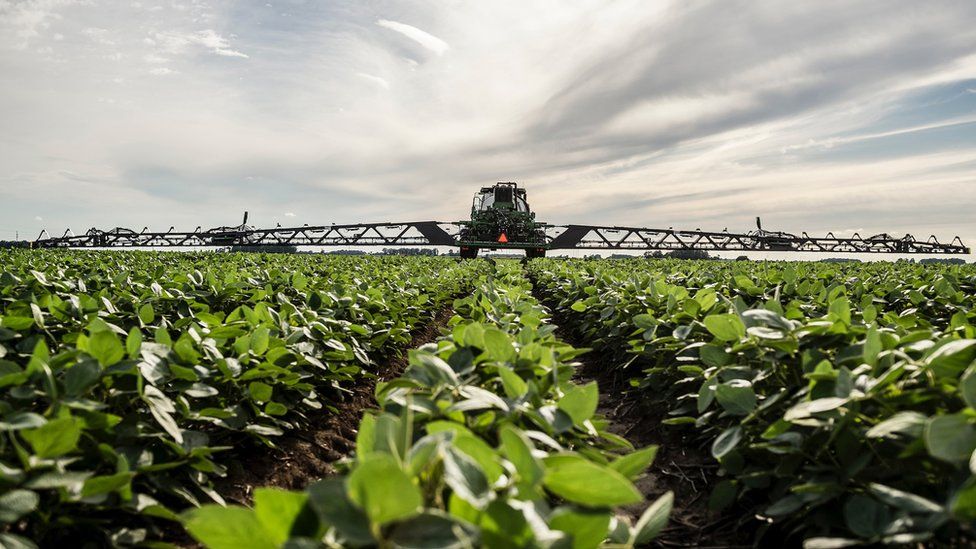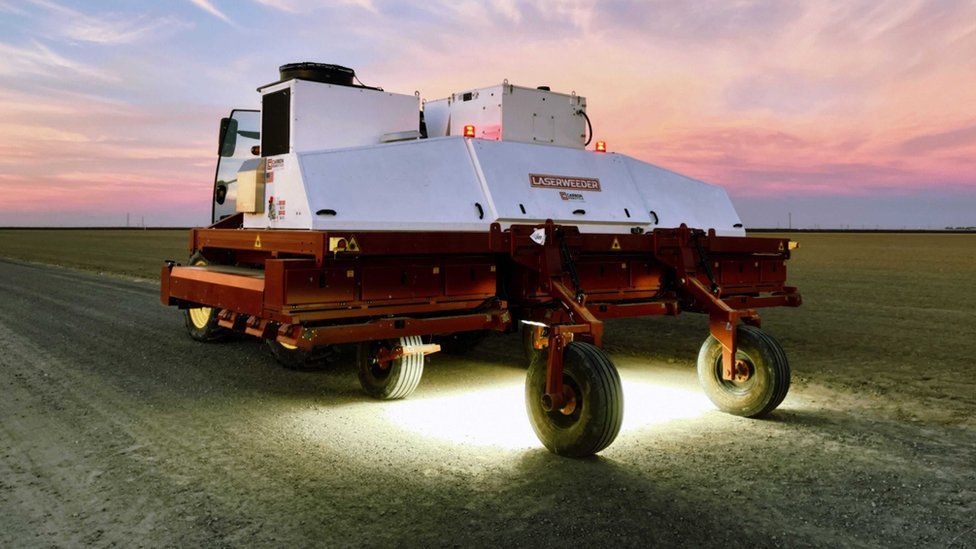The high-tech weeding machines cutting herbicide use

No-one likes weeding, but new technology is helping farmers around the world tackle weeds in a more efficient and environmentally friendly way.
Deanna Kovar from US farming equipment giant John Deere says that the company’s new tractor-pulled weed sprayer can reduce herbicide use by two thirds.
The system, called See & Spray Ultimate, looks like a typical field sprayer, in that two long arms or “booms” stick out either side of the tractor, with spraying nozzles dotted along the underside of each.
What makes this sprayer far more high-tech, is that it is fitted with 36 cameras. These constantly scan the plants in front of them, instantly identifying what is a crop and what is a weed.
Controlled by an artificial intelligence (AI) software system, the connected sprinklers then only spray herbicide onto the individual weeds rather than drenching the entire field.
“Our system is capturing 1.2 billion pixels per second, so it is seeing and processing a lot,” says Ms Kovar, who is vice president of Production and Precision Agriculture Production Systems at John Deere.
To help the software identify the weeds, there are more than 300,000 images on a John Deere database.
The system currently works with three crops – corn, soybean and cotton – and is so far only available in the US.
For farmers elsewhere in the world, a number of rival firms, both large and small, have developed similar smart-weeding technologies. These include German company Bosch BASF Smart Farming, whose camera-scanning weeder is called Smart Spraying Solution.

“The biggest challenge in farming is how weeds compete with crops for space, nutrients and water,” says Nadav Bocher, chief executive and co-founder of Israeli firm Greeneye Technology, another manufacturer of AI-powered precision weeding systems.
His comments echo a 2021 study which said that the annual financial impact of weeds on just one specific crop – winter wheat in the US and Canada – could total $2.2bn (£1.8bn).
“It’s hard to imagine what kind of catastrophic damage farming has done in the past decades [due to excessive use of herbicide],” says Mr Bocher, who claims that Greeneye’s system can reduce usage levels by 80%.
“With such a high level of soil pollution created for no reason, that goes back to us as consumers, and hurts the entire ecosystem.”


New Tech Economy is a series exploring how technological innovation is set to shape the new emerging economic landscape.

Mr Bocher adds that while such high-tech weeding systems are expensive, with Greeneye’s costing around $250,000, a large farm could see annual savings of up to $120,000, due to reduced herbicide costs, and higher crop yields.
“AI is such a steep change in farming’s evolution, it’s like moving from ox to tractor,” says Daniel McCann, who leads a company that is also infusing AI tech into a spraying solution for farmers. But with a twist in this case – his company, Precision AI, uses drones to fly over fields in the US Midwest to target weeds.
Based in Regina, Saskatchewan in Canada, Precision AI fed their database with more than two billion images. Mr McCann says this huge number was necessary because “the same crop can look very different if it was planted in, say, sandier soil compared to soil that gets lots of rain and sun”.

Flying around 10ft (3m) above the ground, the precision spraying drones can bring peace of mind, says Mr McCann. “We now live in a world where the market is increasingly more aware of what’s in their food, and demanding less chemicals on their fruits and veggies and everything else.”
But whatever the advanced spraying method may look like, farmers still face an uphill battle against weeds. “Some weeds evolve to look more like the crop and they can be harder to find,” says Michael Gore, a professor at the SIPS Plant Breeding and Genetics Section at Cornell University.
“Biology often wins in the end, but I like how companies are coming out with these tools that are constantly evolving.”
Given the high cost of these new weeding technologies, some experts would like to see farmers given financial help from their governments, so that they can afford to buy them.
“There is a need for substantive financial subsidies that could help farmers overcome the initial lack of cost-effectiveness of digital technologies,” says Prof Mihalis Kritikos, policy analyst at the European Parliament, and an expert on the legal and ethical aspects of new and emerging technologies.
One weeding innovation that moves away from spraying herbicides altogether instead uses high-powered thermal lasers that zap weeds once they have been identified by AI-enabled cameras.
Called the LaserWeeder, it has been developed by Seattle-based Carbon Robotics, which claims that it can eliminate up to 100,000 weeds per hour when pulled along by a tractor.

The lasers destroy weeds instantly, and the burnt remains are composed back into the soil, explains Paul Mikesell, Carbon Robotics’ chief executive.
So far the system has been used on fields of potatoes, onions and garlic in US states such as California, Washington and Idaho.
Mr Mikesell adds that the first units sold out when released last year, and it is now manufacturing more for the US and Canadian markets. Expansion into Europe is said to be further down the road.
Killing weeds with lasers allows farmer to avoid the dreaded “spray drift” that can happen with herbicide spraying, even if the targeting is as exact as possible. “If you spray anything outside, it will always drift in some way,” Mr Mikesell says.
